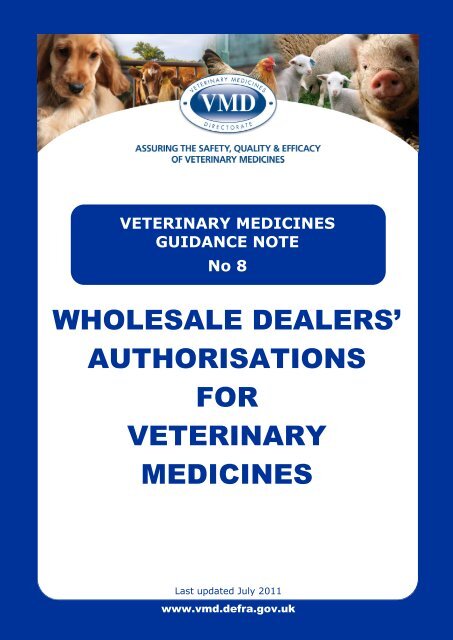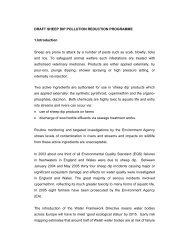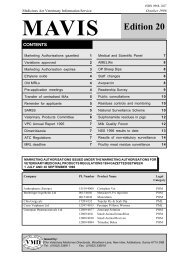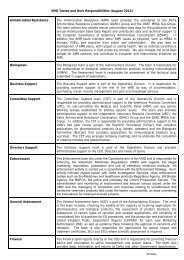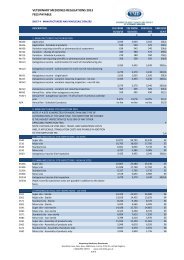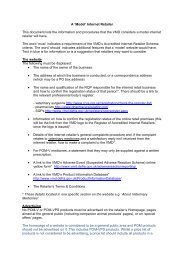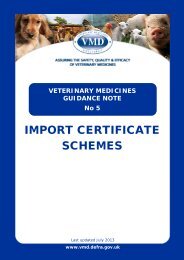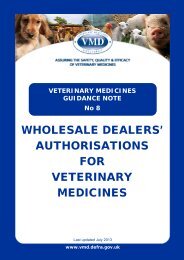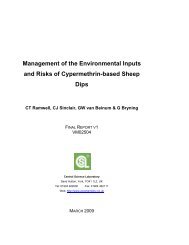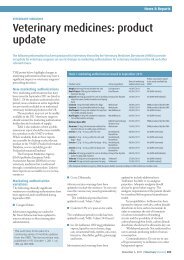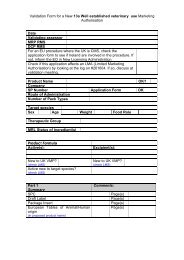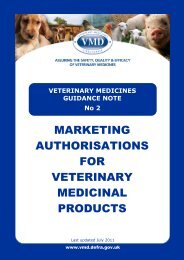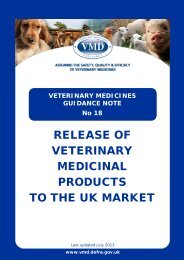TABLE OF CONTENTS - Veterinary Medicines Directorate - Defra
TABLE OF CONTENTS - Veterinary Medicines Directorate - Defra
TABLE OF CONTENTS - Veterinary Medicines Directorate - Defra
- No tags were found...
You also want an ePaper? Increase the reach of your titles
YUMPU automatically turns print PDFs into web optimized ePapers that Google loves.
VETERINARY MEDICINESGUIDANCE NOTENo 8WHOLESALE DEALERS’AUTHORISATIONSFORVETERINARYMEDICINESLast updated July 2011www.vmd.defra.gov.uk
VMGN No. 8QUICK START GUIDEThis <strong>Veterinary</strong> <strong>Medicines</strong> Guidance Note (VMGN) is aimed primarily at those personswho wish to wholesale supply veterinary medicinal products.The quick start guide is a summary of the provisions of the <strong>Veterinary</strong> <strong>Medicines</strong>Regulations (VMR) in relation to wholesale dealing in veterinary medicinal products;detailed information is found in the body of the guidance note.The VMR implement requirements relating to wholesale dealing of veterinary medicinalproducts, which are set out in EU Directive 2001/82 (as amended)http://ec.europa.eu/health/files/eudralex/vol-5/dir_2001_82_cons2009/dir_2001_82_cons2009_en.pdf .For the purposes of the VMR wholesale dealing means the procurement, holding, storageor distribution (whether or not for profit) of a veterinary medicinal product (VMP) to retailersor other wholesale dealers.It is an offence under the VMR for any person to buy a VMP other than by retail, or for thepurposes of retail supply, unless that person has a wholesale dealers‟ authorisation (WDA)granted by the Secretary of State. In order to obtain a WDA, a person must have:a suitable site from where the wholesaling takes placethe services of a Wholesale Dealer Qualified Person (WQP) with responsibility forensuring compliance with EU Guidelines on Good Distribution Practice (GDP)http://ec.europa.eu/health/files/eudralex/vol-4/gdpguidelines1.pdf and maintenance ofa Quality Systemthe services of technically competent staffan effective emergency recall plandocumented procedures to ensure that VMPs are only obtained from, and supplied to,appropriately authorised personsappropriate facilities and equipment, and documented procedures, to ensure that(VMP) are stored in accordance with conditions specified in their authorisationsA WDA holder must keep records of all VMP received and supplied and retain these for 3years.WDA holders are subject to regular inspections by the VMD or, in the case of a WDAholder who also holds a Wholesale Dealers Licence (WL) for human medicines at thesame site, by the <strong>Medicines</strong> and Healthcare products Regulatory Authority (MHRA).FURTHER INFORMATIONFor more information on wholesaling dealing veterinary medicinal products please contactthe VMD‟s Licensing Services‟ Team on 01932 338496 or alternatively contact VMDreception on 01932 336911 and quote “wholesale dealing”.2
VMGN No. 8<strong>TABLE</strong> <strong>OF</strong> <strong>CONTENTS</strong>Contents Paragraph PageIntroduction 1 4Requirements for Obtaining a Wholesale Dealer’sAuthorisation 3 4How to apply for a Wholesale Dealer’s Authorisation 11 6Validity of Authorisations 16 7Variation of Authorisations 20 7Fees 24 8Wholesale Dealer Qualified Person - WQPWQP Requirements 26 8Duties of WQP 35 9Record Keeping Requirements 40 10Contracting Supply to another WDA Holder 43 11Virtual Wholesaling and BrokersVirtual wholesaling 50 12Brokers (and/or buying groups) 51 12Inspections 52 12Further Information 61 14ANNEX 1Guidance on Control and Monitoring ofStorage and Transportation 16ANNEX 2Guidance on the Requirements for aWDA Quality System 20ANNEX 3Requirements for a Wholesale DealerQualified Person (WQP) 22ANNEX 4Good Distribution Practice (GDP)Inspection Criteria – Specimen Report 243
VMGN No. 8Introduction1. This is one of a series of <strong>Veterinary</strong> Medicine Guidance Notes (VMGN) explaining therequirements of the <strong>Veterinary</strong> <strong>Medicines</strong> Regulations (VMR). The VMR are revokedand replaced on a regular basis, so the references to the VMR should be read asreferring to the ones that are currently in force. Therefore, the date and number ofthe Statutory Instrument is not shown in the VMGN. This VMGN will be updated asnecessary and the date of the most recent update is shown on the front cover. TheVMR set out the UK controls on veterinary medicines, including their manufacture,advertising, marketing, supply and administration.2. The VMR set out the UK controls on veterinary medicines, including theirmanufacture, advertising, marketing, supply and administration. VMGN 1 Controls of<strong>Veterinary</strong> <strong>Medicines</strong>, which is published on the <strong>Veterinary</strong> <strong>Medicines</strong> <strong>Directorate</strong>‟s(VMD) website http://www.vmd.defra.gov.uk/pdf/vmr11/VMGN01.pdf provides basicinformation about the scope of the VMR and the requirement for MarketingAuthorisations (MA).This note describes the arrangements for wholesale dealer‟s authorisations (WDA).Requirements for Obtaining a Wholesale Dealer’s Authorisation3. The provisions specifically relating to WDA are set out in Schedule 3 part 2 of theVMR. Failure by the holder of a WDA to comply with the provisions of the VMR is acriminal offence and may result in suspension, or compulsory variation, or revocationof their WDA or prosecution of the WDA holder.4. For the purposes of the VMR, wholesale dealing means the procurement, holding,storage or distribution (whether or not for profit) of a veterinary medicinal product(VMP) to retailers or other wholesale dealers. Only the holder of a marketingauthorisation (MAH), a holder of a manufacturer‟s authorisation (ManA) or the holderof a WDA may wholesale a VMP, or be in possession of a VMP for that purpose; andthey may only wholesale a VMP if their authorisation relates to that product, and onlysupply it to another person permitted under the VMR to wholesale or retail thatproduct.5. Wholesale dealing does not include the retail supply of a VMP to the end user of thatproduct. A WDA is granted by the Secretary of State on being satisfied that anapplicant meets the relevant requirements of the VMR. A WDA may be granted to anindividual or a company.6. The requirements for obtaining a WDA are set out in Schedule 3, paragraphs 18-19of the VMR. These are:(i) The site from which wholesale dealing activities take place must be:weatherproof;secure and lockable;clean;free from contamination;4
VMGN No. 8capable of storing VMP under the required storage conditions.(ii) The WDA Holder must:have the services of technically competent staff;have an effective emergency recall plan;nominate and register a suitable Wholesale Dealer Qualified Person (WQP)responsible for compliance with the principles of GDP as set out in EUGuidelines on Good Distribution Practice of medicinal products for human use(EC Directive 94/C63/03) which can be found on:http://ec.europa.eu/health/documents/eudralex/vol-4/index_en.htm as if theVMP were authorised human medicinal products (please refer to paragraph55 for further details);ensure that the WDA specifies all intended VMP distribution activitiesnotify the VMD (via a variation application) before making any significantchange to the premises or facilities detailed in the WDA, or in the operationsfor which they‟re used;store VMP in accordance with the terms of their marketing authorisations(refer to Annex 1);carry out a stock audit at least annually;provide information or samples to a duly appointed inspector on demand.7. Holders of a WDA are also required to:implement and maintain a quality system (refer to Annex 2);maintain records for at least 3 years and make them available for inspection by aduly appointed inspector;procure VMP only from appropriately authorised manufacturers or wholesaledealers;supply VMP in accordance with their WDA only to persons lawfully permitted toreceive them i.e. retailers who are authorised to supply those veterinarymedicines to end users in accordance with the VMR. For further informationplease refer to VMGN 3 Guidance for Retailers, which is published on the VMDwebsite http://www.vmd.defra.gov.uk/pdf/vmr11/VMGN03.pdf holders of WDArelating to those medicines:• only supply an authorised VMP in accordance with the provisions of thatauthorisation;• ensure proper stock rotation.8. A satisfactory inspection for compliance with GDP is required before a WDA is firstgranted, and thereafter at regular intervals (please see paragraph 50).9. WDA holders who import veterinary medicines that are not authorised in the UK mustfirst ensure that an appropriate import certificate has been obtained from the VMDunless the imported medicines are to be exported immediately. For further guidanceon import certificates please refer to VMGN 5 Import Certificates Schemes which ispublished on the VMD website:http://www.vmd.defra.gov.uk/pdf/vmr11/VMGN05.pdf).10. WDA holders who import a UK authorised veterinary medicine from another MemberState (MS) must notify the holder of the marketing authorisation (MA) for that productof the import, unless the importing wholesaler is also the holder of the relevant MA5
VMGN No. 8(for further information on this type of import please refer to VMGN 2 MarketingAuthorisations For <strong>Veterinary</strong> Medicinal Products which is published on the VMDwebsite:http://www.vmd.defra.gov.uk/pdf/vmr11/VMGN02.pdf).How to apply for a Wholesale Dealer’s Authorisation11. Application forms to wholesale only veterinary medicinal products are available fromthe VMD at:Licensing ServicesVMDWoodham LaneADDLESTONESurreyKT15 3LSTel: 01932 338496E-mail: s.ward@vmd.defra.gsi.gov.ukor they can be downloaded from the VMD website:http://www.vmd.defra.gov.uk/mswd/forms_fees.aspx12. Applications to wholesale both veterinary and human medicines, or an application towholesale veterinary medicines by the holder of a Wholesale Dealer‟s Licence (WDL)for human medicines, should be made to the <strong>Medicines</strong> and Healthcare ProductsRegulatory Agency (MHRA) at:151 Buckingham Palace RoadVictoriaLondonSW1W 9SZ020 3080 6000.E-mail: info@mhra.gsi.gov.ukor downloaded from the MHRA website at:http://www.mhra.gov.uk/Howweregulate/<strong>Medicines</strong>/Licensingofmedicines/Informationforlicenceapplicants/Licenceapplicationforms/index.htm13. If all required information is correctly provided, application forms will be validated bythe VMD within 10 days of receipt and an inspection completed within 90 days of thatvalidation. However, incomplete or incorrect applications will result in validationbeing deferred whilst the VMD contacts the applicant, which will delay the processingof the application. The most common reasons for deferring validation are:no CV for the WQP submitted with the application;no referees for the WQP submitted; andthe declaration in Section 5 unsigned and undated.6
VMGN No. 814. The VMD will only issue a WDA when it is satisfied, following an inspection of thesite(s), that the information contained in the application is accurate and in compliancewith the requirements of the legislation.15. For further advice on how to complete the application form please contact LicensingServices on tel: 01932 338496.Validity of Authorisations16. Once issued, a WDA is valid indefinitely, subject to regular satisfactory inspectionsand continued compliance with the VMR. However, a WDA will lapse if the holderdoes not deal in veterinary medicines for five years.17. A WDA may be suspended or revoked if the requirements of the VMR are notcomplied with.18. The VMD may suspend, vary or revoke a WDA if the holder fails to comply with theVMR or no longer has suitable premises or equipment.19. Where an authorisation is refused, suspended, compulsorily varied or revoked, theapplicant will be offered the opportunity to appeal (for further information please referto VMGN 9 Appeals against Regulatory Decisions which is published on the VMDwebsite http://www.vmd.defra.gov.uk/pdf/vmr11/VMGN09.pdfVariation of Authorisations20. An appropriate variation application must be submitted to and approved by the VMDbefore changes to the information contained in the authorisation documents, such asmaterial alterations to the premises, distribution methods or change of WQP, can bemade. Failure to comply with this requirement could result in the authorisation beingsuspended, revoked or compulsorily varied.21. Application forms to vary a WDA are available from the VMD at:Licensing ServicesVMDWoodham LaneADDLESTONESurreyKT15 3LSTel: 01932 338496E-mail: s.ward@vmd.defra.gsi.gov.ukor they can be downloaded from the VMD website:www.vmd.defra.gov.uk/mswd/forms_fees.aspx7
VMGN No. 822. There are three categories of variations to a WDA:CategoryScientificChangeofownershipOtherPerson responsible forassessmentApplication requiresassessment by an inspectorApplication requiresassessment by an inspectorApplication assessed byadministrative staffExample of variationAddition of a WQPOnly applies to change ofauthorisation holderRemoval of a category ofproducts handled at the site23. A fee is charged for these variations, dependant on the type of variation submitted.(See paragraph 24 – Fees).Fees24. A fee is normally charged for processing WDA applications, including variationapplications, and for site inspections. Wholesale Dealer‟s are also subject to anannual fee. Details of the relevant fees can be found in the VMR, which can befound on www.vmd.defra.gov.uk under Manufacturers, Suppliers, Wholesalers andDistributors.25. Fee reductions apply in respect of WDA applications, annual fees and inspectionfees for businesses whose annual turnover (meaning gross value of all veterinarymedicinal products sold) is less than £35,000. A fee reduction also applies to thosewholesale dealers who only deal in Authorised <strong>Veterinary</strong> <strong>Medicines</strong>-General SalesList (AVM-GSL), Small Animal Exemption Scheme (SAES) products andHomeopathic products.Wholesale Dealer Qualified Person – WQPWQP Requirements26. A WDA holder must have at its disposal, at all times, the services of a WQP who has:adequate knowledge of the activities to be carried out and of the procedures to beperformed under the authorisation; andappropriate experience in those procedures and activities.27. The requirements for appointment as a WQP are similar to those detailed for theResponsible Person (RP) for human medicinal products in the Rules and Guidancefor Pharmaceutical Manufacturers and Distributors 2007 (also known as the OrangeGuide published by the MHRA).28. There is no statutory requirement for the WQP to be a pharmacist, although this isdesirable. However, the WQP should have access to pharmaceutical knowledge andadvice when it is required and have personal knowledge of:8
VMGN No. 8the relevant provisions of the VMR;articles 65-68 of EC Directive 2001/82 on the Community Code relating toveterinary medicinal products, as amended;European Commission Guidelines on Good Distribution Practice of MedicinalProducts for Human Use (94/C 63/03);the conditions attached to the WDA for which the WQP is nominated;the products distributed under the authorisation and the conditions necessary fortheir safe storage and distribution;the categories of persons to whom products may be distributed;the Quality System and Standard Operating Procedures employed by the WDAholder.29. A WQP who is not a pharmacist or a person eligible to act as a Qualified Person (QP)(as defined in EC Directive 2001/82/EC), should have at least one year‟s practicalexperience in both or either of the following areas:handling, storage and distribution of medicinal products;transactions in or selling or procuring medicinal products;30. In addition, the WQP should have at least one year‟s managerial experience incontrolling and directing the activity of the wholesale distribution of medicinalproducts on a scale, and of a kind, appropriate to the authorisation for which thatWQP is nominated.31. It is for the VMD to determine if a particular WQP has the appropriate knowledgeand experience for the scale and nature of the wholesale distribution operation forwhich the WQP is nominated (refer to Annex 3). If unsatisfactory the applicant will beformally informed of the reasons for rejection and the process for appeal.32. The WQP does not have to be an employee of the WDA holder but must be at theWDA holders‟ continuous disposal. Where the WQP is not an employee there shouldbe a written contract that specifies that WQP‟s responsibilities, duties, authority andso on.33. A WQP may be nominated for more than one site but VMD will take intoconsideration the number of sites a WQP is responsible for when deciding whether ornot to grant a WDA.34. The WDA Holder is required to:notify the VMD of the name, address, qualifications and experience of the personwho will carry out the functions of the WQP;notify the VMD of any changes to the WQP;not permit any person to act as the WQP other than the person named on theauthorisation.Duties of the WQP35. To fulfil their duties, the appointed WQP should:have a clear reporting line to either the WDA holder or, where the WDA holder is acompany, to the Managing Director;9
VMGN No. 8have access to all areas, sites, stores and records which relate to the authorisedactivities being carried out;regularly review and monitor all such areas, sites, etc;focus on the management of those activities that are the subject of the WDA, theaccuracy and quality of records, compliance with established standard operatingprocedures (SOPs), the quality of handling and storage equipment and facilities,and the standards achieved; andkeep appropriate records relating to the discharge of the WQP‟s responsibilities.36. The WQP should also ensure that:a quality system is implemented and maintained;the WDA holder complies with GDP guidelines to ensure that the conditions underwhich the authorisation has been granted have been, and are being complied with.37. The WQP may nominate deputies e.g. where the WQP is contracted to the WDAholder or covers more than one site, provided appropriate reporting and delegatingarrangements are in place. These arrangements should include the WQP receivingwritten reports that such actions have been carried out and that the necessarycontrols and checks are in place. There should be documented evidence that thedeputy has received appropriate training to carry out their delegated duties.However, the WQP retains overall responsibility and should personally carry out thedelegated functions at least once a year.38. The WDA holder should ensure that there is a written SOP for receiving advice andcomment from the WQP and recording the consequent action taken.39. Should it prove impossible to resolve a disagreement between the authorisationholder and the WQP with regard to compliance within the terms of the WDA the VMDshould be approached for advice. Whilst a joint referral is preferred, either party mayapproach the VMD for advice independently. A WQP who finds difficulty in meetingtheir statutory responsibilities and the activities being carried out under theauthorisation may, in strict confidence, consult the VMD.Record Keeping Requirements40. WDA holders must keep detailed records for all incoming and outgoing transactions,including disposals, for at least 3 years. The records may be in the form of purchaseand sales invoices, or on a computer, or in any other form, which provides, as aminimum, the following information:the date and nature of the transaction;the identity of the veterinary medicinal product;the manufacturer‟s batch number;the expiry date;the quantity;the name and address of the supplier or recipient.10
VMGN No. 841. The WDA Holder is required to carry out a detailed audit at least once a year. Theaudit must reconcile all incoming and outgoing veterinary medicinal products withproducts currently held in stock with any discrepancies being recorded.42. If discrepancies have occurred, for example, from spillage or breakage it is for theindividual concerned to consider whether any discrepancies are acceptable orwhether further action may be required.Contracting Supply to another WDA Holder43. If one WDA holder acts as a third party storage and distribution site for another WDAholder, an appropriate technical agreement must be put in place between the twobusinesses (and made available to Inspectors). The technical agreement needs tofully describe where the responsibility for various aspects of GDP rests, whether withthe contract giver or the contract acceptor.44. There are no specific guidelines published on technical agreements betweenwholesale dealers or manufacturers/wholesale dealers, but Chapter 7 (pages 80-82of the Rules and Guidance for Pharmaceutical Manufacturers and Distributors 2007)outlines the requirements on Contract Manufacture and Analysis, and sets out theprinciple, details for the contract giver, details for contract acceptor and the contract.These requirements can also form the basis of technical agreements betweenwholesale dealers and their suppliers.45. The contract, or technical agreement, between the two parties should clearly set outthe various activities to be undertaken and detail exactly which company isresponsible for what activity (including any joint responsibilities). The agreementshould also address responsibilities such as:the handling and processing of orders;ensuring that VMP are handled and delivered in accordance with any specificrequirements specified in their SPCs;handling of complaints- in respect of both service and product quality;the recall of VMP;the handling of VMP returns.46. The following scenario serves as an example of when a technical agreement isrequired. WDA holder „A‟ places an order with WDA holder „B‟ for direct delivery to aretail business „C‟. WDA holder „A‟ receives payment from business „C‟ for goodswhich have never actually been handled by WDA holder „A‟ as WDA holder „B‟ isproviding the storage and distribution facility on behalf of WDA holder „A‟. ThereforeWDA holder „A‟ cannot confirm that their own GDP responsibilities have been met inrelation to the products being distributed.47. WDA holder „B‟ should therefore be named on WDA holder „A‟s authorisation as acontracted-out warehousing function and WDA holder „A‟ should perform annualinspections at WDA holder „B‟ (the contracted WDA) under the terms of the technicalagreement between the two parties. Where no such technical agreement exists,11
VMGN No. 8then delivery should only be made by WDA holder „B‟ to WDA holder „A‟s authorisedsite and not directly to the retail business „C‟.48. If no technical agreement is in place, the requirements of the VMR will not be met inrelation to compliance with GDP and it is likely that enforcement action will be takenagainst both WDA holders involved. Such action could result in a temporarysuspension of all related WDA until the matter is resolved.49. Where VMP are delivered to a distribution centre (hub) that is under the managementof a WDA holder for reloading onto vehicles for onward supply, then that hub must bea named site on the WDA. However, if the WDA holder employs the services of 3 rdparty courier to transport VMP and the VMP are delivered to that courier‟s distributioncentre (hub) for reloading onto vehicles for onward supply, there is no requirementfor that hub to be named on the supplying wholesaler‟s WDA or hold a WDA itself,unless the products are cold chain products or, in the case of non cold chainproducts, they are „held‟ at the hub for more than 36 hours.Virtual Wholesaling and BrokersVirtual wholesaling50. The VMR provide that it is an offence to buy a VMP other than by retail, or for thepurposes of retail supply, unless the buyer has a WDA. If VMP are purchased andsold by a business but all of the physical handling is contracted out to another WDAholder the practice is known as „virtual wholesaling‟. A business operating as avirtual wholesaler is required to hold a WDA even though they never physicallyhandle VMP.Brokers (and/or buying groups)51. If a business negotiates terms for a retailer, or group of retailers, to enable them topurchase VMP directly from an MA holder or WDA holder at reduced rates, withoutany VMP being ever bought or sold by the business arranging the terms, then thispractice is referred to as brokering. In these circumstances a broker may receive apayment/commission for their services from the VMP retailers. At the present time abroker is not required to hold a WDA.Inspections52. Wholesale dealers only distributing veterinary medicinal products under a WDA aresubject to regular inspections by the VMD. Inspection enables the VMD to confirmthat WDA holders are complying with the conditions of their authorisation, with theprovisions of the VMR and with the requirements of GDP. Annex 4 sets out the GDPinspection criteria.53. Amongst other things, VMD Inspectors are empowered to:inspect the premises, organised arrangements and procedures used in the storageand distribution of medicinal products;interview key personnel named on authorisation;take samples; and12
VMGN No. 8examine any documentation or records relating to the manufacture, assembly,storage and distribution of veterinary medicinal products.It is a requirement of both EC and UK national legislation that WDA holders shallmake their premises available for inspections by the Licensing Authority at anyreasonable time.54. A fee is charged for these inspections (see paragraph 24).55. Following an inspection, the VMD Inspector will send a letter, within 30 days of thelast day of inspection, to the applicant or WDA holder detailing any deficiencies foundand asking for details of the measures that have been, or will be, taken to correctthem. The applicant‟s or WDA holder‟s responses will then be included in theinspector‟s final report which is sent to the company. The report sets out theinspector‟s observations of the applicant‟s/WDA holder‟s compliance with GDP and,based on those observations, the interval to the next inspection (see paragraph 56).56. In the case of the most serious deficiencies or failure to comply with the VMR, theVMD may consider formal action which can include the refusal to grant a WDA,making a compulsory variation to an existing WDA, suspension or revocation of all orpart of a WDA, or prosecution. The VMD may also take action against the WQP forany failings or omissions by that person.57. Where the VMD takes a decision to suspend, compulsory vary, or revoke a WDA,WDA holders have the right to appeal against such decisions and further guidance isprovided in VMGN 9 Appeals against Regulatory Decisions which can be found onhttp://www.vmd.defra.gov.uk/pdf/vmr11/VMGN09.pdf58. For the purposes of wholesale dealing VMPs, the VMD categorises deficiencies ascritical, major and other (minor). These are based on definitions included in theCompilation of Community Procedures on Inspections and Exchange of Information,which is published on the EMA website:http://www.ema.europa.eu/docs/en_GB/document_library/Regulatory_and_procedural_guideline/2009/10/WC500004706.pdfA Critical deficiency is one that has:produced, or has the potential to produce, a significant risk to human or animalhealth, or the environment; ora deficiency which indicates a significant deviation from the requirements of theVMR through serious negligence or intent.A Major deficiency is a non-critical deficiency that has:produced, or has the potential to produce, a possible risk to human or animalhealth, or the environment; ora deficiency which indicates a major deviation from the requirements of the VMR;ora deficiency which indicates a failure to carry out satisfactory procedures to ensurethat products are stored or distributed in accordance with their specific13
VMGN No. 8requirements; ora combination of several other (minor) deficiencies, none of which on their ownmay be major, but which may together represent a major deficiency and should beexplained and reported as such; orother (minor) deficiencies that have been brought to the attention of the businesson previous occasions.An Other (minor) deficiency is one that is:minor and poses no potential risk to human or animal health, or the environment;ora deficiency which does not indicate a significant deviation from the requirementsof the VMR, Codes‟ of Practice or Guidance; ora deficiency which cannot be classified as either critical or major, because there isinsufficient information to classify it as such.59. Inspection of veterinary only wholesale dealers sites are scheduled at intervals basedon the number and type of deficiencies noted during an inspection, as follows:Inspection findings GDP compliance rating Max inspection interval< 6 others (minor) Good 36 months> 6 minor ≤ 3 major Acceptable 27 months>3 ≤ 5 major Poor 18 months≥ 6 major; any critical Unacceptable -Improvement Notice servedRe-inspect in accordancewith the timescale specifiedon the Improvement Noticeand then 12 monthsTargeted inspections may also take place, for example, when a variationauthorisation is submitted or deficiencies are brought to the attention of the VMD.60. Those WDA holders that also hold a Wholesale Dealer‟s Licence (WDL) to distributehuman medicines are subject to inspection by the MHRA in accordance with theMHRA‟s inspection schedule. Details are provided on the MHRA‟s website:www.mhra.gov.ukFurther Information61. Further information is available from the <strong>Veterinary</strong> <strong>Medicines</strong> <strong>Directorate</strong>, WoodhamLane, New Haw, Addlestone, Surrey, KT15 3LS - Tel: +44 (0)1932 336911; Fax: +44(0)1932 336618 or E-mail: VMGNotes@vmd.defra.gsi.gov.uk. VMGN and other14
VMGN No. 8information, including details of VMD contacts, are available on the VMD website(www.vmd.defra.gov.uk).15
VMGN No. 8ANNEX 1GUIDANCE ON CONTROL AND MONITORING<strong>OF</strong> STORAGE AND TRANSPORTATIONTEMPERATURES16
VMGN No. 8Legislation and good practices oblige pharmaceutical manufacturers and distributors toexercise control over the distribution chain to ensure that the quality of medicines ismaintained. Critical in this regard is control of the environmental conditions under whichmedicines are stored and transported. The MHRA‟s recommendations concerning thecontrol and monitoring of storage and transportation temperatures were published in ThePharmaceutical Journal in July 2001 (1) . A summary of these is given below but the fullguidance can be found on the MHRA‟s website:http://www.mhra.gov.uk/home/groups/comms-ic/documents/publication/con007569.pdfIntroduction1. EU requirements and guidelines on Good Distribution Practice (GDP) requiredistributors to ensure that storage conditions are observed at all times, includingduring transportation. The requirements are applicable not only to medicines thatneed to be stored at low temperatures (known as cold chain products) but also tomedicines that should be stored below 25º or 30º C (known as temperate chainproducts). In addition an increasing number of products require storage andtransportation at sub-zero temperatures and the application of appropriate controls tothese is equally important. What follows gives guidance on how compliance withrelevant standards of good practice may be achieved.Cold Storage2. Many medicinal products require storage at controlled low temperature. Some ofthese such as vaccines, insulins, blood products and some products of biotechnologycan be denatured by freezing and thus must be maintained within a narrowtemperature range above freezing point.3. The temperature in small refrigerators used to store medicines should be measuredcontinuously and the maximum and minimum temperatures recorded daily. Sufficientspace should be maintained to permit adequate air circulation. If the refrigerator isfilled to capacity the effect on temperature distribution should be investigated.Refrigerators used for vaccines and other sensitive products should be capable ofmaintaining the temperature between 2°C and 8°C with the minimum of intervention.Temperature monitoring of these should be by electronic max/min thermometer, withan accuracy of +/– 0.5°C, which should be readable from outside the unit.Refrigerators should not be sited in an environment where extremes of temperature(i.e. 32°C) will affect their performance.4. Large commercial refrigerators and walk-in cold rooms should be monitored with anelectronic temperature-recording device that measures load temperature in one ormore locations, depending on the size of the unit. Portable data-loggers that can bedownloaded onto a computer may be used instead of a fixed device. Records shouldbe checked daily. Internal air temperature distribution should be mapped oninstallation in the empty and full state and annually thereafter under conditions ofnormal use. Products should not be stored in areas shown by temperature mappingto present a risk (e.g. in the airflow from the refrigeration unit). Condensate fromchillers should not be collected inside the unit.1 Taylor J, Recommendations on the control and monitoring of storage and transportation temperatures ofmedicinal products. The Pharmaceutical Journal, 28 July 2001, Volume 267, pages 128-131.17
VMGN No. 85. Temperature alarms should be fitted to large and walk-in units and those smallerunits used to store products at risk from freezing.Controlled room temperature storage6. The simplest monitoring would be with a max/min thermometer placed at a strategiclocation and read, recorded and reset at least weekly, more frequently during periodsof exceptionally hot or cold weather. With the exception of very small stores,temperatures should be recorded at low and high levels. Continuous temperaturerecording is recommended for large warehouses. Self-contained storage areaswithin warehouses, (e.g. CD store, flammables store) should be included intemperature monitoring programmes.7. All warehouses should be temperature mapped to determine the temperaturedistribution under extremes of external temperature. Mapping should be repeatedevery two to three years and after any significant modification to the premises, stocklayout, or heating system. <strong>Medicines</strong> should not be stored in areas shown bytemperature mapping or other consideration to be unsuitable, e.g. at high level inpoorly insulated stores, or next to heaters.TransportationCold-chain goods8. The route and time of transportation, the local seasonal temperatures and the natureof the load should all be considered when arranging cold-chain distribution. Forsmall volumes of cold-chain goods insulated containers may be used, in which caseit is vital that products damaged by freezing are prevented from coming into directcontact with ice packs at subzero temperatures.9. Larger volumes of cold-chain goods should be shipped in refrigerated transport,particularly if transit times may be prolonged. Temperatures within loads of productsat risk from freezing should be strictly controlled and monitored with recording probesor individual temperature monitoring devices, giving consideration to the temperaturegradient within the load. The temperature records for each consignment should bereviewed and there should be a procedure for implementing corrective action in thecase of adverse events.10. Distributors should ensure that consignments of cold-chain goods are clearly labelledwith the required storage/transport conditions. Receivers should satisfy themselvesthat the goods have been transported under appropriate conditions and should placethem in appropriate storage facilities as soon as possible after receipt.Other goods11. Consideration should be given to the possible extremes of temperature insideuninsulated, unventilated delivery vehicles and precautions should be taken toprotect all products from heat challenge. This includes representatives‟ samples keptin car boots and goods distributed using postal services.Systems Checks and Calibration12. Any systems whose performance is critical to preserving the product should betested and demonstrated to achieve what is intended. Measuring and recordingdevices that are used in critical areas (e.g. temperature monitoring of storage andtransport facilities for cold chain goods at risk from freezing) should be calibrated at18
VMGN No. 8least annually against a traceable reference device. Records should include pre andpost-calibration readings and details of any adjustments made or corrections to beapplied. Alarms should be checked for correct functioning at the designated settemperatures.19
VMGN No. 8ANNEX 2GUIDANCE ON THE REQUIREMENTSFOR A WDA QUALITY SYSTEM20
VMGN No. 8WDA holders are required to implement a quality system that includes written proceduresthat describe the different operations which may affect the quality of the products or of thedistribution activity:Documented ProceduresThe WQP‟s defined responsibilities and authority and the requirement for delegatedfunctions to be personally performed by WQP at least once per annumRequirements ensuring VMP are only obtained from authorised „bona fide‟ suppliersProcedure for receipt and checking of deliveriesProcedure for storage of VMP and keeping storage condition recordsProcedure for cleaning and maintenance (including pest control)Procedure for ensuring appropriate security measures are in place on site and duringtransportProcedure for stock rotation and withdrawal of non-conforming products (includingcounterfeits) from saleable stockProcedure for ensuring VMP are only supplied to appropriately authorised customersProcedure for urgent/non-urgent classes of recall and testing of recall planProcedure for assessing returned and recalled VMP and formal release by WQPProcedure for dealing with receiving and processing customer complaintsProcedure for record-keeping, including client orders, returned and recalled VMPAll procedures approved, signed and dated by person responsible for the quality systemRecord KeepingAll records (including electronic computer records) must be maintained so thatsignificant events are traceableRecords of staff trainingRecords to demonstrate that VMP are examined at receipt against order and fordamageRecords of calibration of temperature monitoring devicesRecords of temperature mapping and monitoring of storage area temperaturesRecords maintained for client orders, returned products and recall plansRecords to demonstrate that VMP are only supplied to customers with appropriate bonafides establishedDelivery note containing the date, product name and pharmaceutical form, quantitysupplied and addresses of supplier and customer enclosed with product consignmentsRecords of returned and recalled VMP and assessment and formal release by WQPRecords of customer complaints and actions takenSelf inspections (internal audits) conducted and recorded to monitor compliance withEU GDP and the Quality SystemAll documentation must be retained for 3 years and be readily available for inspection.21
VMGN No. 8ANNEX 3REQUIREMENTS FOR A WHOLESALE DEALERQUALIFIED PERSON (WQP)22
VMGN No. 8The VMR do not specify any formal qualifications or experience necessary to be aWholesale Dealer Qualified Person (WQP), but the VMD considers the following to beacceptable:A) Qualifications/Professional membership<strong>Veterinary</strong> Surgeon (MRCVS)Pharmacist (registered with the GPhC)Chartered Biologist and Member/Fellow of the Society of Biology (CBiolMSB/FSB)Chartered Chemist and Member/Fellow of Royal Society of Chemistry (CChemMRSC/FRSC)Suitably Qualified Person (SQP)B) ExperienceAt least one years experience in:Handling, storage and distribution of medicinal productsTransactions in selling or procuring medicinal productsManaging, controlling and directing the wholesale distribution of medicinalproducts on a scale and kind appropriate to the authorisation for which they arenominatedOther relevant qualification/experience will be considered on a case-by-case basis.C) Supporting DocumentationThe applicant must supply in support of their application:a copy of their relevant Qualificationsa copy of their current Membership of the professional organisation, i.e. MRCVS,GPhC, MSB, MRSC, AMTRAa CV setting out their experience of storing/handling/distributing VMP contactdetails of 2 previous or current employers. The VMD will contact these refereesto request references supporting your experience.23
VMGN No. 8ANNEX 4GOOD DISTRIBUTION PRACTICE (GDP)INSPECTION CRITERIA – SPECIMEN REPORT24
VMGN No. 8Good Distribution Practice (GDP) Inspection Report1. INSPECTION DETAILSWDA Holder Name:WDA HolderAddress:WDA No.:Tel. No.:Fax No.:Email:Web:Site Address:Site No:WQP:Inspected by:Date:25
VMGN No. 8Inspection Type: Scheduled New site TargetedSite Type:Storage &Handling (Pickingof Goods)DistributionOnlyProcurement/administration only (nostorage) „virtual‟LICENSING REQUIREMENTS – in accordance with VMR Yes No N/AHas WDA holder actively traded veterinary medicinal product (VMP) in previous 5years? (Schedule 3, 19)Wholesale dealing activities reflect activities defined in the WDA authorisation?(Schedule 3, 19)Are unauthorised VMP imported using Special Import Certificate (SIC) or SpecialTreatment Certificate (STC)? (Regulation 25(6)b)Does the WDA holder hold a Wholesale Dealer Import Certificate (WDIC) topermit the import and holding of unauthorised VMP? (Regulation 25(6)c)Are imported unauthorised VMP exported? (Regulation 25(4))Is this site named on another WDA or are any WDA activities subcontracted?(Regulation 13)If so, is there a satisfactory technical agreement in place?CommentsCategories of product handled at this site:POM-VPOM-VPSNFA -VPSAVM-GSLUnlicensedVMPList any others below: (e.g. products for administration under thecascade, SAES schedule 6 products, homeopathics)Inspection Fee : Full Reduced (AVM-GSL / annual turnover 5 0 C)Store below 30 0 C(5 to 30 0 C)Store below 25 0 C(5 to25 0 C)Store in aRefrigerator(2 to 8 0 C)Store in a Freezer(
NotApplicableDeficiencyCompliesVMGN No. 8Warehouse/storagefacilities(Give brief description)Refrigerated storageControlled Drugs storeHazardous chemical storeOther (e.g. intermediatehubs/ delivery vehicles)Any changes to the operation since last inspection/planned changes:Key personnel met/contacted during the inspectionName: Position: Qualification no:2. GDP (GOOD DISTRIBUTION PRACTICE) INSPECTION FINDINGS(In accordance with 92/25/EEC and 94/C 63/03)This report details findings of compliance with the GDP requirements required by the current<strong>Veterinary</strong> <strong>Medicines</strong> Regulations at this site. Any failures to comply with Regulations are set outin the relevant section‟s comments and the Non Compliance Letter attached to this report.The section reference numbers in this report relate to Chapter 2 (EU Guidance on WholesaleDistribution Practice) of “Rules and Guidance for Pharmaceutical Distributors 2007” unlessotherwise stated.Key:PERSONNEL C D N/AWholesale Qualified Person (WQP) appointed for site and has definedresponsibility for the quality system? (EU GDP 1)?Where functions are delegated does the WQP personally carry out the activities atleast once per year? (UK Guidance on Wholesale Distribution Practice)Is there an agreement in place for contracted WQPs? (UK Guidance onWholesale Distribution Practice)Key warehouse personnel possess appropriate ability and experience?(EU GDP 2, VMR Schedule 3, 18(4)a))Staff trained and training recorded? (EU GDP 3)Comments27
VMGN No. 8DOCUMENTATION – Orders, Procedures & Records C D N/AAll documentation made available upon request? (EU GDP 4)Products are only obtained from authorised suppliers with appropriate bona fidesestablished? (EU GDP 5)Procedure(s) for receipt and checking of deliveries? (EU GDP 6)Procedure(s) for storage and storage condition records? (EU GDP 6)Procedure(s) for cleaning and maintenance of the premises (including pest control)?(EU GDP 6)Procedure(s) for appropriate security measures in place on site and during transit?(EU GDP 6)Procedure(s) for withdrawal from saleable stock (including counterfeits), client orders,returns and recalls? (EU GDP 6)All procedure(s) approved, signed and dated by person responsible for the qualitysystem? (EU GDP 6)Records maintained for client orders, returned products and recall plans?(EU GDP 6)All records (including electronic computer records) are maintained so that significantevents are traceable? (EU GDP 7)All records are maintained for minimum 5 years (EU GDP 7)Records are kept of each purchase and sale, showing the date of purchase or supply,name of the medicinal product, quantity received or supplied and the name andaddress of the supplier or consignee. (EU GDP 8)Records for transactions between manufacturers and wholesalers ensure traceabilityof origin and destination of medicinal product (using batch numbers) so that allsuppliers and recipients of medicinal product can be identified? (EU GDP 8, VMRRegulation 13)A detailed stock audit is carried out at least once a year?(VMR Schedule 3, 21(1)c)CommentsDELIVERIES TO CUSTOMERS C D N/AProducts are only supplied to customers with appropriate bona fides established? (EUGDP 17)A delivery note is enclosed with product consignments containing the date, productname and pharmaceutical form, quantity supplied and addresses of supplier andcustomer? (EU GDP 18)Arrangements in place for emergency supply? (EU GDP 19)CommentsRETURNS - Non Defective Products, Recall Plans & Counterfeits C D N/AReturns are subject to a systematic examination products by WQP or trained andauthorised staff before return to stock? (EU GDP 23)Formal release of returned products to stock by WQP? (EU GDP 24)Records of returns and formal release kept? (EU GDP 24)28
VMGN No. 8Emergency plan for urgent/non-urgent classes of recall is documented in procedure?(EU GDP 25)Designated person identified as responsible for recall activities?(EU GDP 25)Records kept of recall activity? (EU GDP 26)Emergency plan permits rapid communication to competent authorities in othermember states where product is distributed? (EU GDP 26)Distribution records permit all customers to be identified and contacted in the event ofa recall? (EU GDP 27 28 29)Any recall message is approved by the MAH or competent authority? (EU GDP 30)Any recall message requests the removal and segregation of recalled stock prior tofurther instruction by the MAH? (EU GDP 30)An effective recall system is in place? (EU GDP 27, VMR Schedule 3, 18(4)b)There is a system to segregate any counterfeits found from good stock then alertVMD and MAH? (EU GDP 31)The WQP and the MAH are involved with any counterfeit investigation?(EU GDP 32)Records of counterfeit product receipt, final decision and disposal are kept? (EU GDP32)CommentsSELF INSPECTIONS C D N/ASelf inspections conducted and recorded to monitor compliance with EU GDP and theQuality System? (EU GDP 33)CommentsPREMISES AND EQUIPMENT – Receipt & Storage C D N/APremises and equipment are suitable and adequate to ensure proper conservationand preservation of medicinal products (weatherproof, secure, lockable, clean andfree from contaminants)?(EU GDP 9, VMR Schedule 3,18 )Deliveries protected from bad weather during unloading? (EU GDP 10)Goods-in reception area separate from storage area? (EU GDP 10)Products examined at receipt against order and for damage? (EU GDP 10)Products with specific storage requirements are immediately identified and storedin accordance with written instructions and legal requirements?(EU GDP 11, VMR Schedule 3, 21(1)a)Products are segregated from other goods and stored under manufacturers‟specified conditions? (EU GDP 12)Temperatures are monitored and recorded periodically? (EU GDP 12)Temperature records are subject to regular review? (EU GDP 12)Temperature recorders or other devices indicate excursions? (EU GDP 13)Monitoring devices are calibrated? (EU GDP 9)Temperature control throughout the storage area is demonstrated? (Mapping) (EUGDP 13)29
VMGN No. 8Storage areas are clean and free from litter, dust and pests? (EU GDP 14)Precautions are taken against spillages, breakages, pests and crosscontamination?(EU GDP 14)System in place to ensure stock rotation (FIFO/FEFO)? (EU GDP 15)Regular checks for unsaleable products? (EU GDP 15)Segregated area is available for unsaleable (counterfeit, damaged or expired)stock? (EU GDP 15, 16)Returns are segregated from saleable stock? (EU GDP 22)Products are transported safely and securely? (EU GDP 20)Appropriate storage conditions maintained during transport? (EU GDP 21)CommentsNon-compliances noted at previous inspection: YES NO N/AHave non-compliances raised at the last inspection been resolved?Comments:Documents or samples taken by the InspectorConcluding CommentsConclusion of InspectionClosing meeting with company attended by:30
VMGN No. 8Inspector’s recommendationsInspectionFindings(EMA/INS/GMP/313539/2006Rev 1)? Critical? Major? OtherGDP Compliance RatingGood = < 6 othersAcceptable =
VETERINARY MEDICINES GUIDANCE NOTE<strong>Veterinary</strong> <strong>Medicines</strong> <strong>Directorate</strong>Woodham Lane, New Haw, Addlestone, Surrey KT15 3LSTelephone (+44) (01932) 336911 Fax: (+44) (01932) 336618www.vmd.defra.gov.uk


